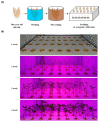Increased Accumulation of Ginsenosides in Panax ginseng Sprouts Cultivated with Kelp Fermentates
- PMID: 38337995
- PMCID: PMC10856821
- DOI: 10.3390/plants13030463
Increased Accumulation of Ginsenosides in Panax ginseng Sprouts Cultivated with Kelp Fermentates
Abstract
Currently, new agri-tech has been developed and adapted for the cultivation of crops using smart farming technologies, e.g., plant factories and hydroponics. Kelp (Laminaria japonica), which has a high industrial value, was considered as an alternative to chemicals for its eco-friendly and sustainably wide use in crop cultivation. In this study, a fermented kelp (FK) was developed for use in hydroponics. The FK contained various free and protein-bound amino acid compositions produced by fermenting the kelp with Saccharomyces cerevisiae. Supplementing FK as an aeroponic medium when cultivating ginseng sprouts (GSs) elevated the total phenolic and flavonoid contents. Additionally, seven ginsenosides (Rg1, Re, Rb1, Rc, Rg2, Rb2, and Rd) in GSs cultivated with FK in a smart-farm system were identified and quantified by a high-performance liquid chromatography-evaporative light scattering detector/mass spectrometry analysis. Administering FK significantly increased the ginsenosides in the GSs compared to the control group, which was cultivated with tap water. These results indicate the FK administration contributed to the increased accumulation of ginsenosides in the GSs. Overall, this study suggests that FK, which contains abundant nutrients for plant growth, can be used as a novel nutrient solution to enhance the ginsenoside content in GSs during hydroponic cultivation.
Keywords: ginseng sprout; ginsenoside; hydroponics; kelp fermentate; nutrient solution.
Conflict of interest statement
The authors declare no conflicts of interest.
Figures



Similar articles
-
Ginsenoside-Enriched Panax ginseng Sprouts Cultivated from Aquaponic System with a Novel Nutrient Solution Regulate LPS-Induced Inflammatory Cytokines and UVB-Induced Photoaging Responses via MAPK/AP-1 Signaling Pathways.Plants (Basel). 2025 Jun 4;14(11):1712. doi: 10.3390/plants14111712. Plants (Basel). 2025. PMID: 40508386 Free PMC article.
-
Simultaneous determination of ginsenosides in Panax ginseng with different growth ages using high-performance liquid chromatography-mass spectrometry.Phytochem Anal. 2006 Nov-Dec;17(6):424-30. doi: 10.1002/pca.944. Phytochem Anal. 2006. PMID: 17144251
-
[Determination of nine ginsenosides in health foods by solid extraction phase-ultra performance liquid chromatography-tandem mass spectrometry].Se Pu. 2021 May;39(5):526-533. doi: 10.3724/SP.J.1123.2020.04028. Se Pu. 2021. PMID: 34227337 Free PMC article. Chinese.
-
Simultaneous determination and difference evaluation of 14 ginsenosides in Panax ginseng roots cultivated in different areas and ages by high-performance liquid chromatography coupled with triple quadrupole mass spectrometer in the multiple reaction-monitoring mode combined with multivariate statistical analysis.J Ginseng Res. 2019 Oct;43(4):508-516. doi: 10.1016/j.jgr.2017.12.001. Epub 2017 Dec 14. J Ginseng Res. 2019. PMID: 31700257 Free PMC article.
-
Comparison of the pharmacological effects of Panax ginseng and Panax quinquefolium.Acta Pharmacol Sin. 2008 Sep;29(9):1103-8. doi: 10.1111/j.1745-7254.2008.00868.x. Acta Pharmacol Sin. 2008. PMID: 18718179 Review.
Cited by
-
Ginsenoside-Enriched Panax ginseng Sprouts Cultivated from Aquaponic System with a Novel Nutrient Solution Regulate LPS-Induced Inflammatory Cytokines and UVB-Induced Photoaging Responses via MAPK/AP-1 Signaling Pathways.Plants (Basel). 2025 Jun 4;14(11):1712. doi: 10.3390/plants14111712. Plants (Basel). 2025. PMID: 40508386 Free PMC article.
-
Microecological mechanisms of mountainous forest cultivated ginseng growth vigor and saponin accumulation, and the characterization of bionic microbial fertilizer.Front Microbiol. 2025 May 13;16:1548481. doi: 10.3389/fmicb.2025.1548481. eCollection 2025. Front Microbiol. 2025. PMID: 40432972 Free PMC article.
-
Efficacy and Safety of Panax ginseng Sprout Extract in Subjective Memory Impairment: A Randomized, Double-Blind, Placebo-Controlled Clinical Trial.Nutrients. 2024 Jun 19;16(12):1952. doi: 10.3390/nu16121952. Nutrients. 2024. PMID: 38931306 Free PMC article. Clinical Trial.
References
-
- Cho K.M., Lee H.Y., Cho D.Y., Jung J.G., Kim M.J., Jeong J.B., Jang S.N., Lee G.O., Sim H.S., Kang M.J., et al. Comprehensive comparison of chemical composition and antioxidant activity of Panax ginseng sprouts by different cultivation systems in a plant factory. Plants. 2022;11:1818. doi: 10.3390/plants11141818. - DOI - PMC - PubMed
Grants and funding
LinkOut - more resources
Full Text Sources
Miscellaneous

